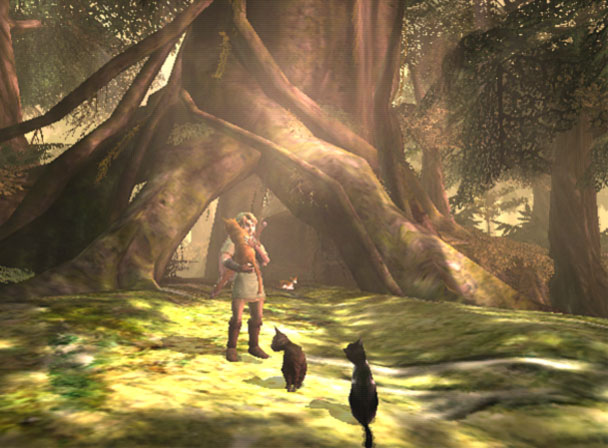Much of the same can also be said for the next two console releases in the series. Both Majora’s Mask and Wind Waker experimented with new artistic directions and structural changes, a repeating time line in the former and sailing in the later, but those classic elements of exploration, combat, and puzzle solving remained the foundation of the games. Of course the story telling was improved for both titles and character development was given an especially important part in Majora’s Mask, but as we have established, that is the one area Nintendo has never hesitated to improve upon.
And then there is Twilight Princess, which is really my inspiration for writing this article. Actually, it came more from some people’s reactions to the Twilight Princess rather than the game itself. Upon its release, the general consensus was that Link’s first Wii/ last GameCube release was an incredible experience. However, there was a fair share of people who argued that Twilight Princess had done too little to evolve and that the series as a whole was growing stale. While everyone is of course entitled to their opinion, I believe these reviews are dead wrong. While it is true that Twilight Princess is in many ways a spiritual successor to Ocarina of Time in terms of design and lacks some of the more experimental aspects of Majora’s Mask or Wind Waker, I don’t really think that matters. The classic Zelda formula that has remained consistent over the years has become timeless, thanks in large part to a general lack of competition.

Cat holding– the biggest innovation since Z targeting
Think back over the last 25 years – what titles have really tried to compete with Zelda directly? Back in the SNES days, the likes of Illusion of Gaia, Secret of Mana, and Terranigma all drew influence from numerous elements of Zelda but also set themselves apart with a greater focus on RPG mechanics and in the case of Secret of Mana, innovative multiplayer adventuring. Fast forward to GameCube and we have Star Fox Adventures, an almost direct attempt at emulating the Zelda formula that ultimately fell short in just about every key element to varying degrees– though the awkward use of the Star Fox universe and characters didn’t help the cause. The most recent, and dare I say most compelling, Zelda-inspired game is Darksiders, a PS3 and Xbox 360 title that intermixes Zelda-style dungeons and tools with combat more akin to God of War. While Darksiders is great game and a solid nod to the Zelda series, it lacks the same level of polish, creativity, and does nothing to really push the concept forward. All of these aforementioned titles are well worth playing, with some being absolutely brilliant, but none really challenge Zelda for the crown of the genre, which we might as well call the Zelda genre at this point.
This lack of competition is definitely a valid reason for not shaking up the series too much over the years, but there is another facet worth exploring. Zelda games are few and far between in an era where major releases in popular series are now only one or two years apart. Major titles like Assassin’s Creed and Call of Duty have become annualized franchises, so constantly adding new ideas has become necessary to justify yearly purchases to the consumer. Twilight Princess came out in 2006, and here we are in 2011 with the release of the next major entry in the series just around the corner. A new Zelda game is a special occasion not for the new ideas it introduces, but simply for the fact that we are getting another entry in a highly polished, very unique series after several years of waiting. Given the average rate for new releases, it isn’t easy to grow tired of what Zelda has to offer.
Considering all I have heard about Skyward Sword, the entire point of this article might soon become rather moot. Early reviews suggest Link’s latest is a rather drastic change of pace with overworlds being more seamlessly intertwined with dungeons, MotionPlus empowered controls setting a new gold standard for the industry, and the best and most cinematic story telling in the franchise’s history. Of course I won’t really know for sure until I get my hands on the game myself, and even then, the thoughts of where the series could go on 3DS or Wii U hover at the back of my mind and are only more likely to grow more pronounced as time goes on. But those are questions for a different article.
Pages: 1 2




 ShareThis
ShareThis







This is a great article. While I don’t believe that man came from monkeys, I do understand the point of the analogy that you are making, and it is an excellent one. Micro-evolution is the only digestible method a beloved video game series should progress in, alongside any necessary adaptation to fit within the console and era. This is proven by the fleeting, rather rambunctious and shifty attempts of Zelda II and Mario Bros. 2. A sequel should never stray too far from its gene pool or else deadly mutations will follow. But by the same token, a cloned successor will fail as well. Nintendo must be ever vigilant to maintain a check and balance.